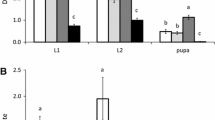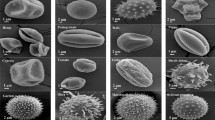Abstract
Although all known phytoseiid mites (Acari: Phytoseiidae) are predators of mites or small insects, many readily feed and reproduce on pollen as well. This ability to feed on food from plant origin increases their survival during periods when prey is locally sparse, but might occur at the expense of the ability to utilize food as efficiently as specialized predators. In this study we compare two predatory mite species used as biological control agents against thrips, Neoseiulus cucumeris and Iphiseius degenerans, with respect to (1) the range of pollen species that may serve as food sources for a sustained oviposition; and (2) the life history and expected intrinsic growth rates on some suitable pollen diets. The results show that I. degenerans is, compared to N. cucumeris, able to utilize a larger proportion of approx. 25 pollen species tested, but does not show equally high ovipositional rates as N. cucumeris. Consequently, the highest intrinsic growth rate for I. degenerans (0.21 day −1) will be surpassed by N. cucumeris.
Similar content being viewed by others
References
Ashihara, W., Hamamura, T. and Shinkaji, N. 1978. Feeding, reproduction and development of Phytoseiulus persimilis Athias-Henriot (Acarina: Phytoseiidae) on various food substances. Bull. Fruit Tree Res. Stn., Japan, E2: 91–98.
Barret, D. and Kreiter, S. 1995. Morphometrics of some phytoseiid predatory mites and characteristics of their habitat: consequences for biological control. In: The Acari: physiological and ecological aspects of acari-host relationships, D. Kropczynska, J. Boczek and A. Tomczyk (eds), pp. 461–473. Dabor, Warszawa.
Castagnoli, M. and Simoni, S. 1990. Biological observations and life table parameters of Amblyseius cucumeris (Oud.) (Acarina: Phytoseiidae) reared on different diets. Redia 73: 569–583.
Charlet, L.D. and McMurtry, J.A. 1977. Systematics and bionomics of predaceous and phytophagous mites associated with pine foliage in California. III. Laboratory studies on the biology of the phytoseiids Metaseiulus validus (Chant) and Typhloseiopsis pini (Chant). Hilgardia 45: 223–236.
Duso, C. and Camporese, P. 1991. Developmental times and oviposition rates of predatory mites Typhlodromus pyri and Amblyseius andersoni (Acari: Phytoseiidae) reared on different foods. Exp. Appl. Acarol. 13: 117–128.
Engel, R. and Ohnesorge, B. 1994. The role of alternative food and microclimate in the system Typhlodromus pyri Scheuten (Acari, Phytoseiidae)-Panonychus ulmi Koch (Acari, Tetranychidae) on grape vines. I. Laboratory investigations. J. Appl. Entomol. 118: 129–150.
Englert, W.D. and Maixner, M. 1988. Rearing of Typhlodromus pyri Scheuten in the laboratory and effects of pesticides on mortality and fecundity of this mite. Nachrichtenbl. Deut. Pflanzenschutzd. 40: 121–124.
Erdtman, G. 1952. Pollen Morphology and Plant Taxonomy — Angiosperms. Almqvist & Wiksell, Stockholm.
Erdtman, G., Praglowski, J. and Nilsson, S. 1963. An Introduction to Scandinavian Pollen Flora — Volume 2. Almqvist & Wiksell, Stockholm.
Eveleigh, E.S. and Chant, D.A. 1981. Experimental studies on acarine predator-prey interactions: the numerical response of immature and adult predators (Acarina: Phytoseiidae). Can. J. Zool. 59: 1407–1418.
Faegri, K. and Van der Pijl, L. 1979. The Principles of Pollination Ecology. Pergamon Press, New York.
Faraji, F., Janssen A., Van Rijn, P.C.J. and Sabelis, M.W. 1999. Kin recognition by the predatory mite Iphiseius degenerans: discrimination among own, conspecific, and heterospecific eggs. Ecol. Entomol., in press.
Flechtmann, C.H.W. and McMurtry, J.A. 1992a. Studies on how phytoseiid mites feed on spider mites and pollen. Internat. J. Acarol. 18: 157–162.
Flechtmann, C.H.W. and McMurtry, J.A. 1992b. Studies of cheliceral and deutosternal morphology of some Phytoseiidae (Acari: Mesostigmata) by scanning electron microscopy. Internat. J. Acarol. 18: 163–169.
Grout, T.G. and Richards, R.I. 1992. The dietary effect of windbreak pollens on longevity and fecundity of a predacious mite Euseius addoensis addoensis (Acari: Phytoseiidae) found in citrus orchards in South Africa. Bull. Entomol. Res. 82: 317–320.
Hulshof, J. and Vänninen, I. 1999. Alternative food sources for thrips predators on cucumber: also a delicacy for the western flower thrips Frankliniella occidentalis. IOBC/WPRS Bull. 22(1): 113–118.
Kennett, C.E., Flaherty, D.L. and Hoffmann, R.W. 1979. Effect of wind-borne pollens on the population dynamics of Amblyseius hibisci (Acarina: Phytoseiidae). Entomophaga 24: 83–98.
Knisley C.B. and Swift, F.C. 1971. Biological studies of Amblyseius umbraticus (Acarina: Phytoseiidae). Ann. Entomol. Soc. Am. 64: 813–822.
Kostiainen, T.S. and Hoy, M.A. 1994. Egg-harvesting allows large scale rearing of Amblyseius finlandicus (Acari: Phytoseiidae) in the laboratory. Exp. Appl. Acarol. 18: 155–165.
Kostiainen, T.S. and Hoy, M.A. 1996. The Phytoseiidae as biological control agents of pest mites and insects; A bibliography. Monograph 17, University of Florida, Gainesville.
Mabberley, D.J. 1997. The Plant-Book. A portable dictionairy of vascular plants. 2nd edn. University Press, Cambridge.
McMurtry, J.A. 1977. Some predaceous mites (Phytoseiidae) on citrus in the Mediterranean region. Entomophaga 22: 19–30.
McMurtry, J.A. 1992. Dynamics and potential impact of ‘generalist’ phytoseiids in agroecosystems and possibilities for establishment of exotic species. Exp. Appl. Acarol. 14: 371–382.
McMurtry, J.A. and Croft, B.A. 1997. Life-styles of phytoseiid mites and their role in biological control. Ann. Rev. Entomol. 42: 291–321.
McMurtry, J.A. and Johnson, H.G. 1964. Some factors influencing the abundance of predacious mite Amblyseius hibisci in southern California (Acarina: Phytoseiidae). Ann. Entomol. Soc. Am. 58: 49–56.
McMurtry, J.A. and Rodriguez, J.G. 1987. Nutritional ecology of phytoseiid mites. In: Nutritional ecology of insects, mites, spiders and related invertebrates, F. Slansky Jr. and J. G. Rodriguez (eds), pp. 609–644. John Wiley & Son, New York.
McMurtry, J.A. and Scriven, G.T. 1964. Studies on the feeding, reproduction and development of Amblyseius hibisci (Acarina: Phytoseiidae) on various food substances. Ann. Entomol. Soc. Am. 57: 649–655.
Moore, P.D., Webb, J.A. and Collinson, M.E. 1991. Pollen analysis. Blackwell, Oxford.
Nwilene, F.E. and Nachman, G. 1996. Reproductive responses of Iphiseius degenerans and Neoseiulus teke (Acari: Phytoseiidae) to changes in the density of the cassava green mite, Mononychellus tanajoa (Acari: Tetranychidae). Exp. Appl. Acarol. 20: 273–282.
Ouyang, Y., Grafton-Cardwell, E.E. and Bugg, R.L. 1992. Effects of various pollens on development, survivorship and reproduction of Euseius tularensis (Acari: Phytoseiidae). Environ. Entomol. 21: 1371–1376.
Overmeer, W.P.J. 1981. Notes on breeding phytoseiid mites from orchards (Acarina: Phytoseiidae) in the laboratory. Med. Fac. Landbouww. Rijksuniv. Gent 46: 503–509.
Ramakers, P.M.J. 1983. Mass production and introduction of Amblyseius mckenziei and A. cucumeris. IOBC/WPRS Bull. 6: 203–206.
Ramakers, P.M.J. 1990. Manipulation of phytoseiid thrips predators in the absence of thrips. IOBC/WPRS Bull. 13: 169–172.
Ramakers, P.M.J. and Voet, S.J.P. 1995. Use of castor bean, Ricinus communis, for the introduction of the thrips predator Amblyseius degenerans on glasshouse-grown sweet pepper. Meded. Fac. Landbouww. Rijksuniv. Gent 60/3a: 885–891.
Ramakers, P.M.J. and Voet, S.J.P. 1996. Introduction of Amblyseius degenerans for thrips control in sweet peppers with potted plants of castor beans as banker plants. IOBC/WPRS Bull. 19: 127–130.
Sabelis, M.W. and Bakker, F.M. 1992. How predatory mites cope with the web of their tetranychid prey: a functional view on dorsal chaetotaxy in the Phytoseiidae. Exp. Appl. Acarol. 16: 203–225.
Sabelis, M.W. and Janssen, A. 1994. Evolution of life history patterns in the Phytoseiidae. In: Life History and Reproductive Patterns of Mites, M.A. Houck (ed.), pp. 70–97. Chapman & Hall, New York.
Sabelis, M.W. and Van Rijn, P.C.J. 1997. Predation by insects and mites. In: Thrips as Crop Pests, T. Lewis (ed.). pp. 259–354. CAB-International, London.
Saito, Y. and H. Mori, 1975. The effects of pollen as an alternative food for three species of phytoseiid mites (Acarina: Phytoseiidae). Mem. Fac. Agr., Hokkaido Univ. 9: 236–246.
Schausberger, P. 1992. Vergleichende Untersuchungen über den Einfluss unterschiedlicher Nahrung auf die Praeimaginalentwicklung und die Reproduktion von Amblyseius aberrans Oud. und A. finlandicus Oud.(Acarina, Phytoseiidae). J. Appl. Ent. 113: 476–486.
Swirski, E., Amitai, S. and Dorzia, N. 1967. Laboratory studies on the feeding, development and reproduction of the predacious mite Amblyseius rubini Swirski and Amitai and A. swirskii Athias (Acarina: Phytoseiidae) on various kinds of food substances. Israel J. Agr. Res. 17: 101–119.
Swirski, E., Amitai, S. and Dorzia, N. 1970. Laboratory studies on the feeding habits, post-embryonic survival and oviposition of the predatory mites, Amblyseius chilenensis Dosse and Amblyseius hibisci Chant (Acarina: Phytoseiidae) on various kinds of food substances. Entomophaga 15: 93–106.
Takafuji, A. and Chant, D.A. 1976. Comparative studies of two species of predacious phytoseiid mites (Acarina: Phytoseiidae), with special reference to their responses to the density of their prey. Res. Popul. Ecol. 17: 255–310.
Tanigoshi, L.K. 1981. Advances in the knowledge of the biology of the Phytoseiidae. In: Recent Advances in Knowledge of the Phytoseiidae, M.A. Hoy (ed.), Publ. 3284, pp. 1–22. University of California Press, Berkeley.
Tanaka, M. and Kashio, T. 1977. Biological studies on Amblyseius largoensis Muma (Acari: Phytoseiidae) as a predator of the citrus red mite, Panonychus citri (McGregor) (Acarina: Tetranychidae). Bull. Fruit Tree Res. Stn. Japan, D1: 49–67.
Van Houten, Y.M. and Van Stratum, P. 1993. Biological control of westernflower thrips in greenhouse sweet peppers using non-diapausing predatory mites. Proc. Exper Appl. Entomol., N.E.V. Amsterdam 4: 229–234.
Van Houten, Y.M. and Van Stratum, P. 1995. Control of western flower thrips on sweet pepper in winter with Amblyseius cucumeris (Oudemans) and A. degenerans Berlese. In: Thrips biology and management, B. L. Parker, M. Skinner and T. Lewis (eds), pp. 245–248. Plenum Press, New York.
Van Houten, Y.M., Van Rijn, P.C.J., Tanigoshi, L.K., Van Stratum, P. and Bruin, J. 1995. Preselection of predatory mites for year-round control of western flower thrips (Frankliniella occidentalis), in greenhouse crops. Entomol. Exp. Appl. 74: 225–234.
Van Rijn, P.C.J. and Sabelis, M.W. 1993. Does alternative food always enhance biological control? The effect of pollen on the interaction between western flower thrips and its predators. IOBC/WPRS Bull. 16: 123–125.
Van Rijn, P.C.J. and Tanigoshi, L.K. 1999. The contribution of extrafloral nectar to the survival and reproduction of the predatory mite Iphiseius degenerans on Ricinus communis. Exp. Appl. Acarol. 23: 281–296.
Van Rijn, P.C.J. and Van Houten, Y.M. 1991. Life history of Amblyseius cucumeris and Amblyseius barkeri (Acarina: Phytoseiidae) on a diet of pollen. In: Modern Acarology, Vol. 2, F. Dusbabek and V. Bukva (eds), pp. 647–654. Academia, Prague.
Van Rijn, P.C.J., Van Houten, Y.M. and Sabelis, M.W. 1999. Pollen improves thrips control with predatory mites. IOBC/WPRS Bull. 22(1): 209–212.
Rights and permissions
About this article
Cite this article
Van Rijn, P.C., Tanigoshi, L.K. Pollen as Food for the Predatory Mites Iphiseius Degenerans and Neoseiulus Cucumeris (Acari: Phytoseiidae): Dietary Range and Life History. Exp Appl Acarol 23, 785–802 (1999). https://doi.org/10.1023/A:1006227704122
Issue Date:
DOI: https://doi.org/10.1023/A:1006227704122




